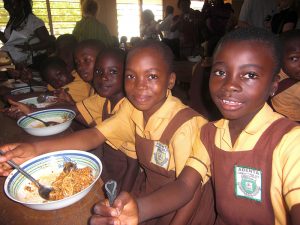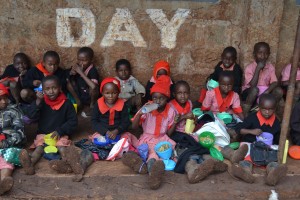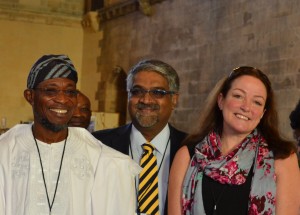The World Health Organisation (WHO) estimates that over 44 million children under five are either overweight or obese. At the same time in low and middle income countries one in five children are stunted due to poor diets. Malnutrition’s triple burden of stunting, micro-nutrient deficiency and obesity is a fact of life for many of the world’s children.
The good news is that every school day 368 million children sit down to a school meal.
This is important because we know from extensive research that school feeding is an effective way to fight malnutrition and improve life outcomes.
Governments in sub-Saharan Africa are increasingly looking at ways to scale up sustainable school feeding programmes that source their food from local farmers. Known as Home Grown School Feeding these programmes can potentially act as a ‘win-win’ for local communities by providing free nutritious school meals to children whilst at the same time providing a market for the produce of local farmers.
One such country is Ghana, which through its Ghana School Feeding Programme provides free school meals to over 1.7 million children every school day.
To meet this challenge, Imperial College London’s Partnership for Child Development (PCD) in partnership with Dubai Cares is working with the government to pioneer a new approach that is tackling child malnutrition head-on by linking together nutritious school meals with community focused nutrition and hygiene training.
Gingerbread and buckets
Creating nutritionally balanced school meals using local ingredients is not an easy thing to do. This is doubly true when the children relying on school meals are from communities where food insecurity is high and malnutrition and anaemia are common conditions.
 To help schools and caterers to develop nutritious school meals, PCD has launched a state of the art, easy to use web-based school meals planner which allows users to create and fully cost menus using locally available ingredients. By linking local market prices to the ingredients, the tool displays the actual cost of each meal to the user. With this information, programme managers are able to create accurate and realistic school meals budgets.
To help schools and caterers to develop nutritious school meals, PCD has launched a state of the art, easy to use web-based school meals planner which allows users to create and fully cost menus using locally available ingredients. By linking local market prices to the ingredients, the tool displays the actual cost of each meal to the user. With this information, programme managers are able to create accurate and realistic school meals budgets.
The strength of the tool lies in its simplicity; you don’t need to be a nutritionist to create healthy nutritionally balanced meals. Gingerbread children graphics to show how much a meal is meeting the recommended daily intake of nutrients as identified by the WHO.
The tool is designed to work in conjunction with ‘handy measures’ – everyday measuring utensils like buckets and spoons which PCD has calibrated to international standard units so that caterers can accurately recreate nutritionally balanced meals without having to buy expensive kitchen scales and equipment.
One such caterer is Stella who has just been employed by the Government to cook for the 100 children that attend the New Mangonese Primary School on the outskirts of Accra, Ghana’s capital city, “I’ve learnt a lot in terms of how to prepare food hygienically and measure it out accurately so I’m cooking the right amounts”.
Healthy Homes
Good child nutrition and hygiene starts at home. To ensure this, the programme is promoting healthier lifestyles by training 400 community based health and nutrition champions to take the healthy living message deep into their local communities.
Through community meetings, the distribution of tens of thousands of health posters and radio jingles, community leaders and parents are being taught simple and practical ways to ensure that their children stay healthy and happy.
As mother of two, Mercy Awonor from Accra, can attest these health messages are getting through to parents and children alike, “I always knew the importance of cooking my children healthy meals but I wasn’t always sure what food was good and what was bad. Now with all the posters around the village and the health messages on the radio I know the food I should be cooking. My children also know what is good for them”.
PCD’s Executive Director Dr. Lesley Drake says, “By coupling high tech digital resources such as the meals planner with low tech community engagement, integrated school feeding and health programmes are vital if governments are to tackle the malnutrition crisis facing the next generation”.
To find out more and to plan your own school meal visit http://www.hgsf-global.org/
Follow HGSFglobal
Like us on Facebook Facebook/HomeGrownSchoolFeeding
Francis Peel
Partnership for Child Development
Imperial College London
Read How buckets and digital gingerbread men are beating child malnutrition in Ghana in full


 To help schools and caterers to develop nutritious school meals, PCD has launched a state of the art,
To help schools and caterers to develop nutritious school meals, PCD has launched a state of the art, 
